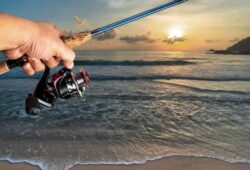Why is snagging fish illegal?
This is something that many people ask, especially the ones who are fascinating in this activity.
Although fishing is an enjoyable outdoor experience, it is definitely not very easy. This is why many people try out different techniques just to help them get a good catch. One of these is snagging.
So why is snagging fish illegal? And for the sake of those who are not familiar with this practice, what exactly is snagging, anyway? We’ll tackle these questions today!
Contents
Why Is Snagging Fish Illegal? Understanding The Reasons Behind
For the most part, snagging fish has made the act of catching fish easier and more convenient. But at the same time, there are anglers who are not in favor of this practice.
Snagging fish is illegal because of the impact it has on the fish population. For instance, abuse on these marine animals can arise once anglers have discovered how very easy it is to simply catch them. Fish gets hooked just about anywhere, and it ends up being a non-sustainable means of fishing.
Additionally, snagging can hurt fish really bad. When they get to escape, they sustain stress and wounds on their flesh from being snagged. They suffer and undergo so much pain until they die. Fish can also be oxygen-deprived as a result of snagging, particularly when caught close to the tail and hauled forcefully backward.
And lastly, snagging does not reflect sportsmanship. There is no fair chance given to others because the angler feels empowered to snag as many fish as possible. In the end, it does not quite enhance their skills but becomes a display of power and greed.
The Act Of Snagging Fish
Basically, snagging fish is a means of catching fish with hooks. This does not give fish a chance to take the bait. As a result, snag-fishing causes the fish to get badly pierced in random parts of their body. This is what happens instead of getting hooked right in the mouth.
When they do not willingly or voluntarily take the bait, instead they are snagged, they do not have any “consent” at all to get caught. Among the fishes that are prone to this unlawful practice is the Paddlefish, as well as others that are more keen to eat planktons than lures.
Legality Of Snag-Fishing In The US
While individual states have their own laws when it comes to snagging fish, most of the 50 states classify snag-fishing as illegal. Among the states that prohibit this fishing practice are:
- Alabama
- Delaware
- Hawaii
- California
- Massachusetts
- Indiana
- Georgia
- Maryland
- Minnesota
- New Jersey
- Pennsylvania
- Michigan
- North Carolina
- Rhode Island
- New Hampshire
- Wyoming
- Texas
- Washington
- Vermont
- South Carolina
- Wisconsin
As for the other states, they only allow snag-fishing to rough fishes or non-game fish. These states include:
- Connecticut
- Arizona
- Louisiana
- Florida
- Kansas
- Missouri
- Maine
- Iowa
- Idaho
- North Dakota
- Nebraska
- New York
- Montana
- Oklahoma
- Ohio
- Tennessee
- Oregon
- West Virginia
- Oregon
- Virginia
As for the other states not included in the list such as Illinois, South Dakota, Alaska, Kentucky, and Mississippi, snagging fish remains completely legal. They don’t prohibit this practice, yet they have some regulations set in place to make sure fishery resources do not become abused over time.
Most game fishes are being protected from snagging in many states. As for non-game fishes, there are no restrictions on snagging them. Among the different game fish that can be snagged legally are catfish, muskie, trout, walleye, northern pike, kokanee, whitefish, panfish, bass, and others. The same holds true for buffalo, gar, suckers, and carp.
Read More: Is Fishing With Corn Illegal in Texas? Learn the Law Before Fishing!
Is Accidental Snagging Illegal?

It is also worth noting that there are possible instances when an angler catches fish in other body parts instead of the mouth. This is the case with unintentional snagging.
Accidental snagging occurs after trolling or dragging through a school of fish. The same happens when your target misses the lure after striking voluntarily.
But you need to take note of the fact that when your fish is accidentally (or intentionally) pierced past its gill plate, it is already considered as snagging. Thus, you need to release the fish right away.
However, if the fish is snagged on the mouth or head area, it remains to be acceptable and not exactly considered as foul-hooking.
Some anglers perform certain techniques deliberately. This is the case with snagging fishes intentionally in the head, which is a form of disguise to the illegal fishing method. It is common with salmon fishing where a practice such as flossing is performed.
What this means is that the hook is tied up with a fishing line right in the water. Then, they wait until the fish picks the line up with its mouth and swims upstream. Hence, this results in a catch. Unfortunately, it is simply another form of snagging.
Conclusion
Fishing is an activity that requires patience and persistence.
But for those who want to get it done fast, they consider snag-fishing to easily catch their target. Unfortunately, it is an illegal act that tends to kill fish and hurt them intensely.
This is why snagging fish is illegal as it is a form of animal cruelty. Instead of being a sport, angling done this way becomes abusive and torturous to the fish. Hence, it is best to avoid this practice and catch fish in a more decent way that will not cause harm to your target.




